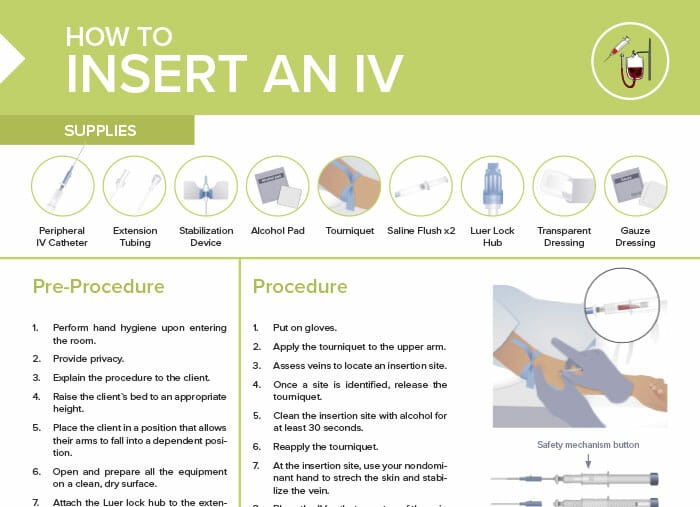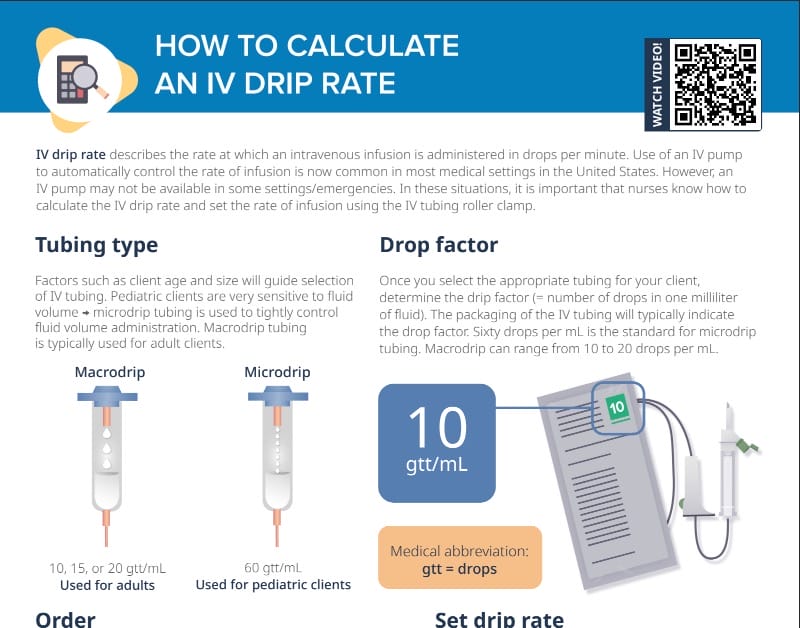What is IV drip rate?
IV drip rate describes the rate at which an intravenous infusion is administered in drops per minute.
Use of an IV pump to automatically control the rate of infusion is now common in most medical settings in the United States; however, an IV pump may not be available in some settings/emergencies. In these situations, it is important that nurses know how to calculate the IV drip rate and set the rate of infusion using the IV tubing roller clamp.
How to select the correct tubing type
Factors such as client age and size will guide selection of IV tubing. Different tubing types deliver a larger or smaller number of drops per milliliter. Pediatric clients are very sensitive to fluid volume, so microdrip tubing is used to tightly control fluid volume administration (60 gtt(mL). Macrodrip tubing (10, 15, or 20 gtt/mL) is typically used for adult clients.
What is the drop factor?
The drop factor (or drip factor) refers to the number of drops (gtts) that make up one milliliter of fluid. Specific to the type of IV tubing being used (typically indicated on the packaging), it is used to calculate the flow rate for manual IV infusions.
Example order for IV infusion
Typically, the order will include the volume of medication or fluid to be infused and either a rate per hour or the overall duration of the infusion.
It is your job as the nurse to use this information to determine the IV drip rate in gtt/min.
Sample order:
0.9% normal saline, 1000 mL IV over 8 hr
How to calculate IV flow rate: Drops per minute
We are using the example order of 0.9% normal saline, 1000 mL IV over 8 hr for the calculation. The drop factor is 10 gtts/mL.
Step 1: Convert time units to get the total infusion time in minutes
Total infusion time in minutes: The order states 8 hours, which is calculated by multiplying 60 minutes x 8 hours, equaling 480 minutes overall.
Step 2: Calculate gtt per minute with the IV drip rate formula
Formula:
$$ Drip\ rate\ (gtt/min) = \frac{(Total\ volume\ [mL]) \times (Drop\ factor\ [gtt/mL])}{Time\ [minutes]} $$- The total volume is given in the order.
- The drop factor is determined by the use of the correct tubing, which is required for the calculation.
- The time is the overall infusion time in minutes.
Since you can’t actually administer a fraction of a drop, if you get a fraction as a result, round to the nearest whole number.
How to set the drip rate
To set the IV drip rate, count the drops as fluid enters the drip chamber. Adjust the roller clamp until you count the correct number of drops entering the chamber per minute (21 for our example above). For safety, label IV bag with the ordered rate and time the hourly markings for infusion.

